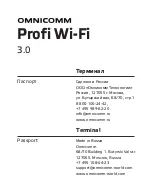
EZVAVINST
Date: 10-2016
Supersedes: 7-2016
Nailor reserves the right to change any information concerning product or specification without notice or obligation.
Page 35 of 48
Installation and Operation Manual
●
EZvav Digital Controls
Occupancy Sequence
An EZvav controller is designed to operate as a stand-alone controller and determine occupancy based only on the availability of
primary airflow and motion in the zone. The controller can be in any one of the following occupancy states.
•
Occupied
•
Unoccupied
•
Standby
Occupancy can also be commanded by another BACnet device or an operator workstation connected to the building automation
network. See the topic System Integration and Networking on page 41 for details.
Automatic occupancy
If Automatic Occupancy is enabled, the controller will automatically toggle between Unoccupied, Occupied, and Standby based on
the presence of primary airflow and motion in the zone.
The default for Automatic Occupancy is Disabled. See the topic Advanced options on page 21 to change Automatic Occupancy.
Occupied
For controllers without a connected motion sensor, the controller changes to Occupied upon the detection of primary airflow.
Controllers with a connected motion sensor change to Occupied upon the detection of primary airflow and motion in the space.
The unit will remain in the Occupied state as long as periodic motion is detected and primary airflow continues. If motion stops,
the controller changes to Standby.
Unoccupied
The controller Occupancy mode changes to Unoccupied when it detects a loss of primary airflow. While in the Unoccupied state,
the controller will fully open the damper in an attempt to reach the maximum airflow set point.
Loss of primary airflow is defined as less than 25% of the requested flow for at least 5 minutes. The Occupancy mode changes to
Occupied or Standby once the actual airflow is at least 30% of the requested flow.
Standby
In units with a connected motion sensor, the controller starts in Standby and changes to Occupied after detecting motion in the
space. Motion in the space is defined as two movements detected within 5 minutes. The controller will change back to Standby
after a lack of motion for the period specified by the variable Standby Time.
Standby mode is not valid for controllers without a motion sensor, unless commanded by a building management system.
Space Set Points
There are four temperature set points each for heating and cooling for a total of eight set points.
•
Active cooling
•
Occupied cooling
•
Unoccupied cooling
•
Standby cooling
Types of set points
The EZvav controllers may use any of the following set points based on a user entered set point or the state of occupancy and
standby which is described in the topic Occupancy sequence on page 35.
Active set point—The active set point is the current set point. The active set point is determined by the following.
•
If the space is occupied, the controller uses the occupied set point as the active set point.
•
If the space is unoccupied the controller uses the unoccupied set point as the active set point.
•
If controller occupancy is Standby, the controller calculates the standby set point.
•
A user with Password 1 can enter an active set point from a EZvav digital wall sensor. This entry will change the occupied
set point within the set point limits.
•
If a sensor with a dial set point is connect to the controller, the dial position is used for the active set point only when the
Occupancy state is Occupied.
Occupied set point
—A temperature set point entered by the controls technician during controller setup and system commissioning.
This is the set point used when the controller is occupied which is determined by primary airflow and, on controllers equipped with
motion sensors, motion in the zone.
•
Active heating
•
Occupied heating
•
Unoccupied heating
•
Standby heating
















































